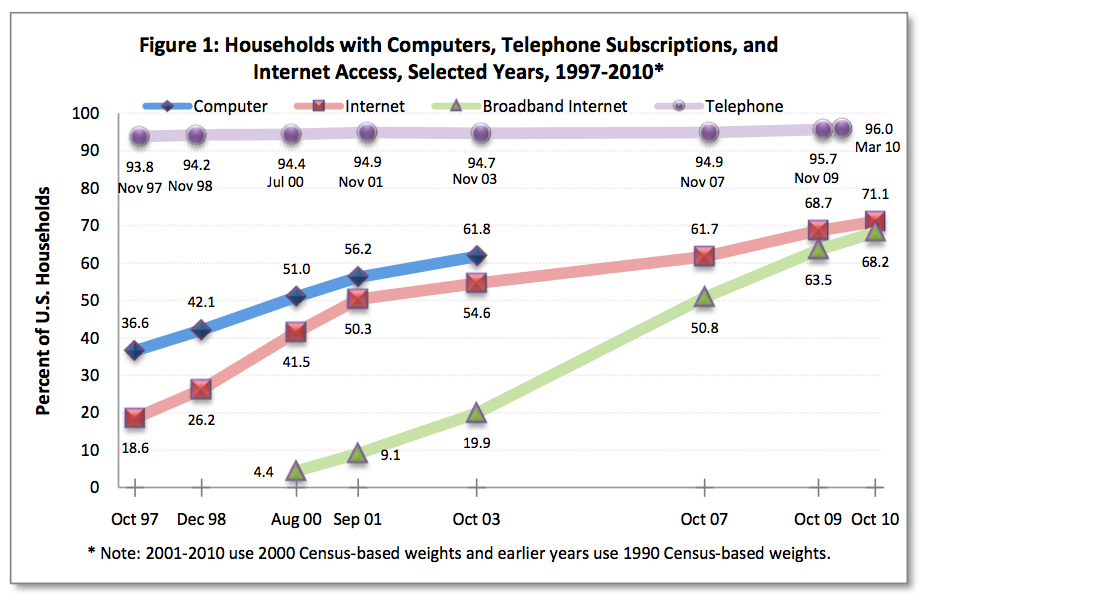U.S. Department of Commerce
National Telecommunications & Information Administration
Executive Summary
The new millennium has witnessed a rapid rise in broadband Internet connections in the United States. While the growth rate of total Internet connections at home slowed somewhat after 2001, the number of household broadband connections grew rapidly over the last decade. As of October 2010, the nationwide broadband adoption rate equaled 68.2 percent of households, up from 63.5 percent one year earlier. Overall, the growth of broadband Internet adoption in the United States stems from two sources: (1) supplanting dial-up services in many households, and (2) expanding the market for household Internet connections.
The nationwide trend toward widespread adoption of broadband Internet connections has occurred among virtually all demographic groups, with nearly universal year-over-year growth. Adoption and growth rates, however, are uneven among various demographic groups. Over the past year, gaps decreased in a number of demographic categories, but persisted with respect to family income, education, age, race/ethnicity, employment status, household type, and disability status. Gender-specific adoption rates remained at virtual parity. The average urban-rural differential narrowed, but a ten-percentage point gap remains. State-specific adoption varied widely. Almost 72 percent of Americans use the Internet at some location, increasing from 68.4 percent twelve months prior. The most popular locations for Internet access outside the home are the workplace and school, followed by public libraries and “someone else’s house.”
Nationwide, non-adoption at home for the Internet and broadband stands at 28.9 percent and 31.8 percent of households, respectively. The proportion of all persons who do not use the Internet anywhere equals 28.3 percent. For households that do not connect to broadband, the reason given most frequently for non-adoption was “don’t need/not interested,” followed by “too expensive.” This ranking holds for the main sub-category of this group (i.e., those who do not use the Internet anywhere), but the cost factor ranks first for non-broadband households that either only use the Internet outside the home, or only connect through dial-up. Cost also becomes more important in such decisions for lower-income, and Black non-Hispanic and Hispanic households. Urban and rural households both rank “don’t need,” “too expensive,” and “no/inadequate computer” as their top three reasons for non-adoption, but lack of broadband availability was much more significant in rural areas (9.4%) than urban locales (1.0%).
…
Access and Use
Over the last decade, the number of household broadband Internet connections in the United States has risen rapidly. In August 2000, home broadband connections were quite rare, present in just 4.4 percent of households. Internet use in general had already become relatively popular, with connections in 41.5 percent of households, but the vast majority of Internet-using Americans relied on dial-up service at home. By October 2010, however, the landscape shifted dramatically, with 68.2 percent of households connecting via broadband, while 2.8 percent of households used dial-up service (see Figure 1).
As Figure 1 shows, the growth in broadband connections accelerated during most of the last decade, but the rate of growth in total Internet connections at home slowed after 2001. Overall, broadband Internet adoption in the United States traces its growth to two phenomena: (1) supplanting dial-up services in many households, and (2) expanding the market for household Internet connections. These numbers suggest that Americans have developed a strong preference for high-speed connections and the applications they enable. Although the gap between home broadband Internet adoption and telephone subscribership has narrowed over time, household use of broadband currently remains more than 25 percentage points behind.
The nationwide trend toward increased adoption of broadband Internet connections is observable among virtually all demographic groups, with year-over-year growth present almost universally. However, adoption and growth rates are uneven among various demographic groups, and such disparities warrant further investigation.
Download full report (PDF): Digital Nation
About the National Telecommunications & Information Administration
www.ntia.doc.gov
“The National Telecommunications and Information Administration is an agency in the U.S. Department of Commerce that serves as the executive branch agency principally responsible for advising the President on telecommunications and information policies. In this role, NTIA frequently works with other Executive Branch agencies to develop and present the Administration’s position on these issues. Since its creation in 1978, NTIA has been at the cutting edge of critical issues. In addition to representing the Executive Branch in both domestic and international telecommunications and information policy activities, NTIA also manages the Federal use of spectrum; performs cutting-edge telecommunications research and engineering, including resolving technical telecommunications issues for the Federal government and private sector; and administers infrastructure and public telecommunications facilities grants.”
Tags: Computers, DOC, Information, Internet Access, National Telecommunications & Information Administration, NTIA, U.S. Department of Commerce







 RSS Feed
RSS Feed